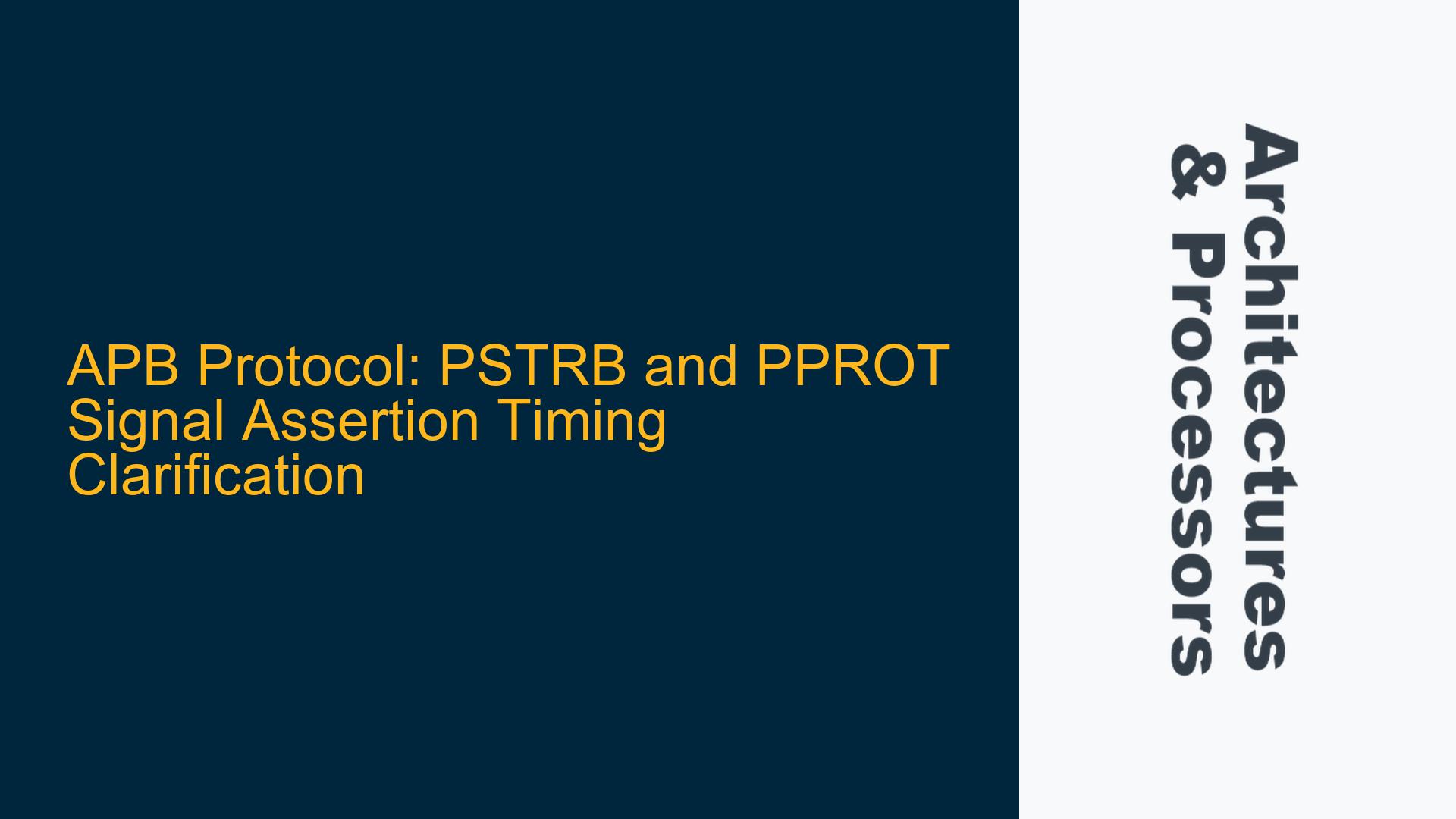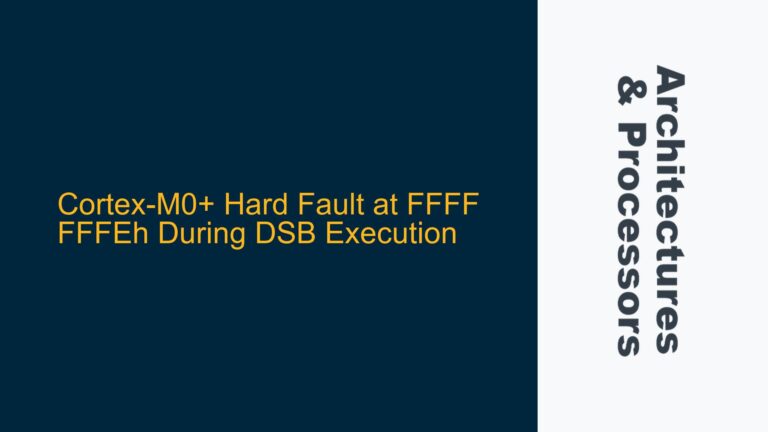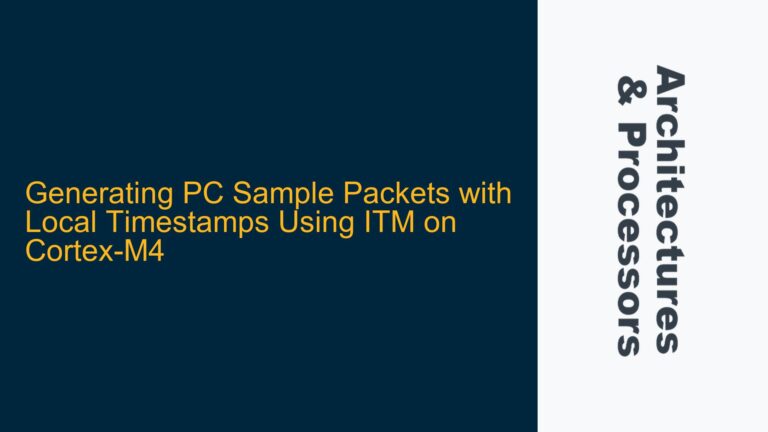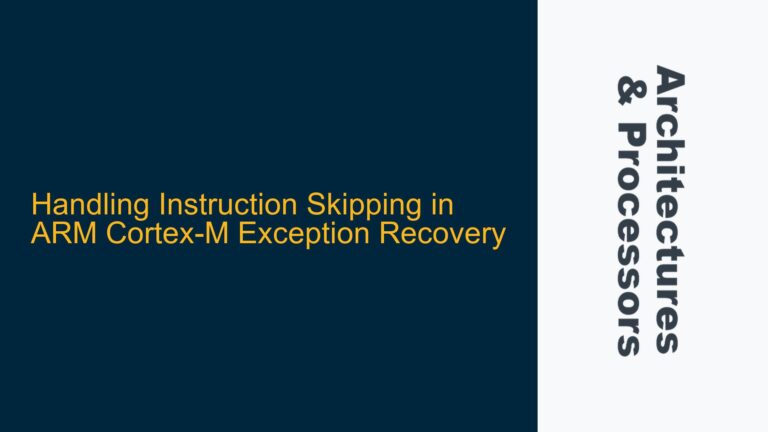APB4 Protocol Signal Assertion Timing Ambiguity for PSTRB and PPROT
The Advanced Peripheral Bus (APB) protocol, part of the ARM AMBA family, is widely used for low-bandwidth, low-power peripheral interfacing in SoC designs. The APB4 specification (IHI0024C) introduces two critical signals: PSTRB (Write Strobe) and PPROT (Protection Signal). These signals enhance the functionality of the APB protocol by enabling byte-level write operations and providing protection attributes for transactions, respectively. However, the APB4 specification does not explicitly define the assertion timing for these signals, leading to ambiguity in their implementation and verification.
The core issue revolves around when PSTRB and PPROT should be asserted relative to other control signals such as PSEL, PADDR, and PWDATA. While the specification mandates that control signals (except PENABLE) must remain constant during a transfer, it does not explicitly state whether PSTRB and PPROT fall under this category. This ambiguity can lead to misinterpretation during RTL design and verification, potentially causing functional errors in the SoC.
The PSTRB signal is used to indicate which bytes of the PWDATA bus are valid during a write transaction. It is particularly useful for byte-addressable peripherals where only specific bytes need to be written. On the other hand, PPROT provides protection attributes for the transaction, such as secure/non-secure access, privileged/user mode access, and data/instruction access. Both signals are critical for ensuring correct operation and security in modern SoCs.
The lack of explicit timing requirements for PSTRB and PPROT in the APB4 specification can lead to inconsistencies in their implementation. For example, if PSTRB is not asserted at the correct time, a peripheral might misinterpret which bytes of PWDATA are valid, leading to data corruption. Similarly, if PPROT is not asserted correctly, it could result in unauthorized access to secure or privileged resources, compromising the system’s security.
Misinterpretation of APB4 Specification and Control Signal Timing
The ambiguity in the APB4 specification arises from the fact that PSTRB and PPROT were introduced in the latest revision of the protocol, and their timing requirements were not explicitly documented. This omission can lead to several potential causes of misinterpretation and implementation errors.
One possible cause is the assumption that PSTRB and PPROT follow the same timing requirements as other control signals such as PADDR and PWDATA. While this assumption is reasonable, it is not explicitly stated in the specification. This can lead to inconsistencies in how different designers and verification engineers interpret the timing requirements for these signals.
Another potential cause is the lack of clear diagrams or examples in the specification that show the timing relationship between PSTRB, PPROT, and other control signals. The APB4 specification includes timing diagrams for other signals, but these diagrams do not include PSTRB and PPROT. This absence can lead to confusion, especially for engineers who rely heavily on visual representations to understand protocol timing.
Additionally, the specification does not explicitly state whether PSTRB and PPROT are considered control signals. While PSTRB is closely related to PWDATA and PPROT is similar to other control signals like PADDR, their classification is not clearly defined. This lack of clarity can lead to different interpretations of their timing requirements, especially in complex SoC designs where multiple peripherals and bus masters are involved.
The timing of PSTRB and PPROT is particularly critical in systems where multiple transactions are occurring simultaneously, or where the bus is shared between multiple masters. In such scenarios, incorrect timing of these signals can lead to race conditions, data corruption, or security vulnerabilities. For example, if PSTRB is not asserted at the correct time, a peripheral might latch incorrect data, leading to functional errors. Similarly, if PPROT is not asserted correctly, it could result in unauthorized access to secure resources, compromising the system’s integrity.
Implementing Correct Timing for PSTRB and PPROT in APB4 Designs
To address the ambiguity in the APB4 specification and ensure correct implementation of PSTRB and PPROT, designers and verification engineers should follow a systematic approach that includes careful analysis of the protocol, adherence to best practices, and thorough verification.
Step 1: Define Timing Requirements for PSTRB and PPROT
The first step is to define the timing requirements for PSTRB and PPROT based on the existing APB4 specification and best practices. Since the specification does not explicitly state the timing for these signals, it is reasonable to assume that they follow the same timing requirements as other control signals. Specifically, PSTRB and PPROT should be asserted when PSEL is high and remain constant throughout the transfer, just like PADDR and PWDATA.
To formalize this, the following timing requirements should be implemented:
- PSTRB and PPROT must be asserted in the same clock cycle as PSEL.
- PSTRB and PPROT must remain stable and unchanged while PSEL is high.
- PSTRB and PPROT can only change in the clock cycle after PENABLE is de-asserted, indicating the end of the transfer.
Step 2: Update RTL Design to Adhere to Defined Timing
Once the timing requirements are defined, the next step is to update the RTL design to ensure that PSTRB and PPROT adhere to these requirements. This involves modifying the state machine or logic that generates these signals to ensure that they are asserted and de-asserted at the correct times.
For example, in a typical APB state machine, the following modifications should be made:
- In the SETUP state, when PSEL is asserted, PSTRB and PPROT should also be asserted.
- In the ACCESS state, PSTRB and PPROT should remain stable until PENABLE is de-asserted.
- In the IDLE state, PSTRB and PPROT should be de-asserted.
Step 3: Develop Comprehensive Verification Testbenches
To ensure that the timing requirements for PSTRB and PPROT are correctly implemented, comprehensive verification testbenches should be developed. These testbenches should include scenarios that cover all possible timing conditions for these signals, including edge cases where PSTRB and PPROT change state.
The verification testbenches should include the following tests:
- Basic Timing Tests: Verify that PSTRB and PPROT are asserted and de-asserted at the correct times relative to PSEL and PENABLE.
- Concurrency Tests: Verify that PSTRB and PPROT remain stable during back-to-back transfers or when multiple peripherals are accessed simultaneously.
- Error Condition Tests: Verify that the system handles incorrect timing of PSTRB and PPROT gracefully, such as when these signals change state during a transfer.
Step 4: Perform Timing Analysis and Debugging
After implementing the RTL design and verification testbenches, the next step is to perform timing analysis and debugging to ensure that the timing requirements for PSTRB and PPROT are met. This involves using simulation tools to analyze the timing of these signals and identify any issues.
Timing analysis should focus on the following areas:
- Setup and Hold Times: Ensure that PSTRB and PPROT meet the setup and hold times required by the peripherals.
- Signal Stability: Verify that PSTRB and PPROT remain stable during the entire transfer, even in the presence of clock skew or jitter.
- Cross-Domain Synchronization: If PSTRB and PPROT are generated in a different clock domain, ensure that proper synchronization techniques are used to avoid metastability.
Step 5: Document and Review Timing Requirements
Finally, it is important to document the timing requirements for PSTRB and PPROT and review them with the design and verification teams. This documentation should include detailed timing diagrams, state machine descriptions, and verification plans. The review process should involve cross-checking the timing requirements with the APB4 specification and ensuring that all team members have a clear understanding of the timing constraints.
By following these steps, designers and verification engineers can ensure that PSTRB and PPROT are implemented correctly in APB4 designs, avoiding potential functional errors and security vulnerabilities. Additionally, this approach can serve as a reference for future updates to the APB4 specification, helping to clarify the timing requirements for these signals and prevent similar issues in the future.
Conclusion
The ambiguity in the APB4 specification regarding the assertion timing of PSTRB and PPROT can lead to significant challenges in SoC design and verification. However, by systematically defining the timing requirements, updating the RTL design, developing comprehensive verification testbenches, performing timing analysis, and documenting the requirements, designers and verification engineers can ensure that these signals are implemented correctly. This approach not only addresses the current issue but also provides a framework for handling similar ambiguities in future protocol revisions.






